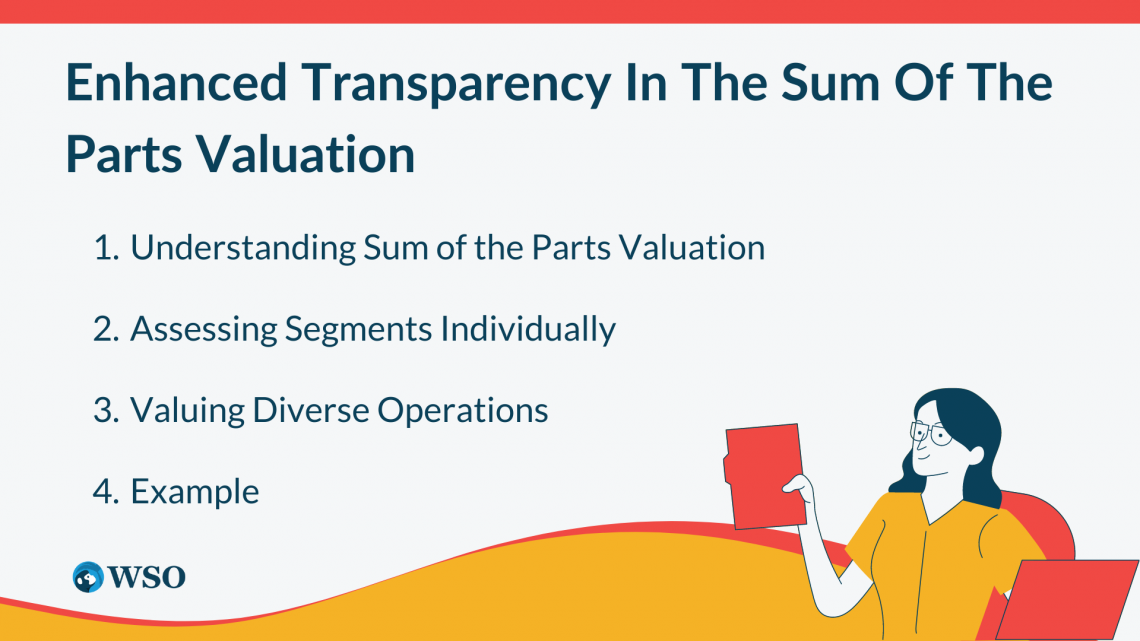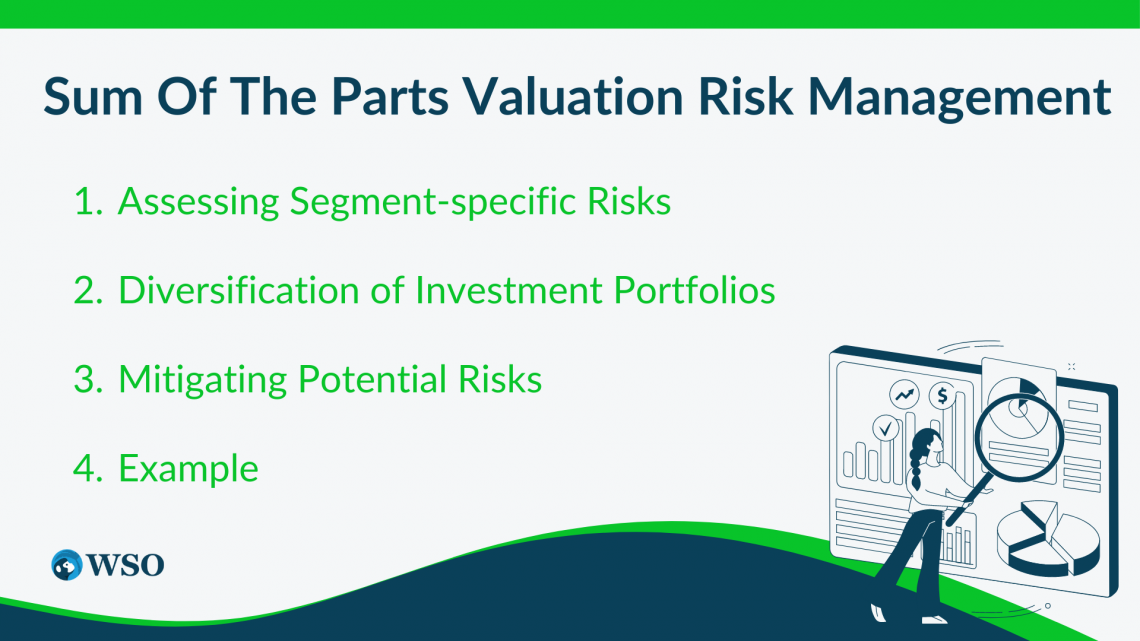Sum Of The Parts (SOTP) Valuation
The Sum of the Parts Valuation breaks down a company into its business segments or assets to determine its true value.
What Is The Sum of the Parts Valuation?
The Sum of the Parts Valuation is a powerful financial technique used to determine a company's intrinsic value by evaluating its business segments or assets.

This valuation approach entails assessing the worth of each segment independently and then aggregating them to determine the company's overall value.
By dissecting a company into its constituent parts, investors can gain a deeper understanding of its true worth and uncover hidden value.
The formula for Sum of the Parts Valuation is straightforward:
Total Value = Value of Segment 1 + Value of Segment 2 + ... + Value of Segment n
To illustrate how Sum of the Parts Valuation works, let's consider a hypothetical conglomerate, ABC Corporation, which operates in three distinct industries: automotive, electronics, and real estate.
Each segment contributes differently to the company's overall value:
- Automotive Segment: This segment includes manufacturing and selling automobiles.
- Electronics Segment: This segment involves the production and distribution of consumer electronics. The valuation of this segment considers factors like brand reputation, market demand, technological innovation, and competitive landscape.
- Real Estate Segment: This segment encompasses the ownership and development of commercial and residential properties.
An investor can assign a value to each segment based on relevant valuation metrics and
industry benchmarks by conducting an in-depth analysis of each segment.
Once the individual values are determined, they are summed up to arrive at the total value of ABC Corporation. This article will cover the key benefits of using this valuation method.
Key Takeaways
- The Sum of the Parts Valuation breaks down a company into its business segments or assets to determine its true value.
- This approach provides insights into hidden value and helps investors make informed decisions in the financial markets.
- The formula for Sum of the Parts Valuation is straightforward:
Total Value = Value of Segment 1 + Value of Segment 2 + ... + Value of Segment n
- Enhanced transparency is one of the key benefits of using Sum of the Parts Valuation, as it allows investors to evaluate the performance and prospects of each segment individually.
- This valuation method enables investors to identify undervalued segments and capitalize on their untapped potential.
Enhanced Transparency in The Sum of the Parts Valuation
The Sum of the Parts Valuation is a valuation method that offers enhanced transparency by breaking down a company's value into its core components.

1. Understanding Sum of the Parts Valuation
This method involves assessing the value of a company by analyzing its various business segments separately and then summing them up to determine the overall worth.
The approach recognizes that different segments may have different growth rates, risk profiles, and market dynamics, which can impact the company's overall value.
2. Assessing Segments Individually
Using this valuation, each business segment is evaluated based on its specific financial metrics, such as revenue, earnings, and cash flow.
Note
Assessing allows investors to gain insights into each segment's performance and potential, which may vary significantly within a company.
3. Valuing Diverse Operations
Companies with diverse operations across multiple industries or sectors can benefit greatly from this valuation method.
By valuing each segment independently, investors can better understand the value drivers and risks associated with each business line, enabling more informed investment decisions.
4. Example
To illustrate this, let us consider Company XYZ, a conglomerate with three main business segments: A, B, and C.
- Segment A: This segment operates in the technology sector and has been experiencing rapid growth, with strong revenue and profit margins. Analysts value Segment A at $500 million.
- Segment B: Company XYZ's second segment is in the manufacturing industry, which has been facing challenges due to increased competition. However, it still generates steady cash flow. Segment B is estimated to be worth $300 million.
- Segment C: The third segment operates in the healthcare sector and is characterized by stable and predictable earnings. It has a strong market position and is valued at $200 million.
By summing up the individual valuations of each segment, the total value of Company XYZ would be $1 billion.
Uncovering Hidden Value in The Sum of the Parts Valuation
The Sum of the Parts Valuation is a powerful method that unveils hidden value within a company by evaluating each segment individually. This approach enables investors to identify undervalued segments and potentially capitalize on their untapped potential.

1. Identifying Undervalued Segments
One of its significant benefits is the ability to identify undervalued segments within a company.
While a company's overall performance may not accurately reflect the potential of each segment, this valuation method allows investors to uncover hidden gems that the company's aggregate performance might mask.
2. Capitalizing on Potential
By recognizing undervalued segments through this valuation, investors have the opportunity to capitalize on their potential.
Note
These undervalued segments may have unique growth prospects, competitive advantages, or untapped markets that, once realized, can drive significant value for the company and its shareholders.
3. Example
To illustrate the concept, let's consider Company XYZ, a conglomerate with three main business segments: A, B, and C.
- Segment A: This segment operates in the technology industry and consistently delivers strong revenue growth and high-profit margins. However, its contribution to the overall company's value may not be fully reflected.
- Segment B: Company XYZ's second segment is in the consumer goods sector. While it has faced challenges due to increased competition, a thorough analysis reveals that it possesses valuable intellectual property rights and a loyal customer base.
- Segment C: The third segment operates in the energy sector. Despite currently facing a temporary decline in revenue due to market fluctuations, it has a robust pipeline of upcoming projects that are expected to contribute significantly to its long-term value.
4. Maximizing Investment Returns
This valuation method empowers investors to maximize their investment returns by identifying undervalued segments and making informed investment decisions.
By evaluating each segment individually, investors can allocate their capital strategically, focusing on segments with the greatest potential for growth and value creation.
Note
By applying the Sum of the Parts Valuation, investors can recognize the hidden value within each segment and potentially capitalize on the opportunities they present.
Strategic Decision Making in The Sum of the Parts Valuation
The Sum of the Parts Valuation is a powerful technique that enables management and investors to make strategic decisions by understanding each segment's contribution to a company's overall value.

This valuation approach helps allocate resources, prioritize investments, and optimize business operations for maximum efficiency and profitability.
1. The Significance of Sum of the Parts Valuation
This valuation plays a crucial role in strategic decision-making by providing insights into the value and performance of each business segment within a company.
By evaluating each segment individually and considering its unique characteristics, management, and investors can gain a comprehensive understanding of the company's overall value and growth potential.
2. Allocating Resources Effectively
One of its key advantages is the ability to aid in resource allocation. By quantifying the value of each segment, management can determine the significance of each business unit and allocate resources accordingly.
Note
Allocating helps ensure that resources are distributed efficiently, focusing on segments that have the potential to generate higher returns and contribute more significantly to the company's overall value.
3. Prioritizing Investments
This method also assists in prioritizing investments. By evaluating each segment's performance, growth prospects, and profitability, management can identify segments that require additional investment or strategic focus.
This approach allows them to prioritize investments based on the segments' potential to generate higher returns and increase the company's overall value.
4. Optimizing Business Operations
Understanding the individual contributions of each segment through this valuation enables management to optimize business operations effectively.
By identifying segments that are underperforming or lagging, management can take corrective measures to improve their performance and align them with the overall business strategy.
Note
Optimizing may involve implementing operational improvements, exploring cost-saving measures, or reallocating resources to enhance the segment's profitability and value.
5. Example
Let us consider Company ABC, a diversified conglomerate operating in various industries, to illustrate the practical application of Sum of the Parts Valuation in strategic decision-making.
- Segment X: This segment represents the company's core business and contributes the highest value to the overall company.
- By evaluating its growth potential and competitive position, management can allocate resources to strengthen this segment's market position further and drive sustainable growth.
- Segment Y: Although Segment Y currently generates moderate returns, a deeper analysis reveals its untapped potential.
- By identifying specific growth opportunities, management can make strategic investments and initiatives to unlock its hidden value, thereby increasing its contribution to the company's overall worth.
- Segment Z: Despite being a smaller segment, Segment Z operates in a niche market with high growth potential.
- Utilizing this valuation method allows management to recognize its significance and allocate resources to fuel its expansion and capture a larger market share.
Note
By leveraging the insights gained from the Sum of the Parts Valuation, management at Company ABC can make informed decisions on resource allocation, prioritize investments, and optimize business operations to maximize the company's overall value and profitability.
Sum of the Parts Valuation Risk Management
The Sum of the Parts Valuation helps investors assess segment-specific risks, diversify portfolios, and mitigate potential risks. Investors can use this approach to evaluate market volatility, regulatory challenges, and technological disruptions.

Understanding risk profiles allows them to make informed decisions to safeguard investments and maximize returns.
1. Assessing Segment-specific Risks
Another of its key benefits is the ability to help investors assess the risk associated with different company segments. Each segment may have its own unique set of risks, such as market volatility, regulatory challenges, or technological disruptions.
2. Diversification of Investment Portfolios
This valuation enables investors to diversify their investment portfolios by understanding the risk profile of each segment. This approach helps in creating a well-balanced investment strategy that can withstand market fluctuations and deliver more stable returns.
3. Mitigating Potential Risks
Through Sum of the Parts Valuation, investors can identify segments with higher risk levels. This insight allows them to take appropriate measures to mitigate these risks effectively.
As an illustration, investors have the flexibility to allocate a smaller portion of their portfolio to segments with higher risks. Additionally, they can adopt risk management strategies like hedging or diversifying their investments across various asset classes.
Note
These approaches allow investors to safeguard their portfolios by balancing the potential for higher returns with the need for risk mitigation.
4. Example
To illustrate the application of Sum of the Parts Valuation in risk management, let us consider Company XYZ, a multinational corporation operating in various sectors.
- Segment A: This segment operates in a highly regulated industry, which poses compliance and regulatory risks.
By evaluating the specific risks associated with this segment, investors can allocate their resources accordingly and implement risk mitigation strategies, such as staying updated on regulatory changes and establishing robust compliance procedures.
- Segment B: This segment is exposed to market volatility due to its reliance on commodity prices. By gaining a comprehensive understanding of the inherent risks tied to volatile commodity prices, investors can take proactive measures to safeguard their investments.
This includes employing hedging techniques, diversifying their portfolios, or even exploring alternative strategies. Such actions help to mitigate the adverse effects of price fluctuations on their overall investment performance, ensuring greater stability and potential returns.
- Segment C: This segment is subject to technological disruptions and competitive pressures.
By assessing the risks related to technological advancements and market competition, investors can make informed decisions regarding their investment in this segment, such as monitoring industry trends and staying ahead of technological advancements.
By utilizing this valuation method, investors in Company XYZ can gain insights into the risk profiles of each segment and take appropriate risk management measures.
Note
This approach allows them to diversify their portfolios, allocate resources effectively, and make informed investment decisions, ultimately mitigating potential risks and maximizing their returns.
Conclusion
The Sum of the Parts Valuation is highly regarded among investors and analysts as an invaluable tool in helping discern the hidden value of a company.

Its effectiveness lies in the ability to deconstruct a firm into its fundamental components and evaluate them individually. This provides investors with a profound understanding of its concealed worth.
Aside from revealing hidden value, investors are also equipped with the knowledge needed to make well-informed decisions and successfully navigate the intricate landscape of the financial markets.
By using this valuation method, investors can uncover value hidden within a company's various segments.
This method provides a more accurate representation of a company's overall worth, as it considers each segment's performance and prospects.
This enhanced transparency enables investors to identify undervalued segments and potentially capitalize on their potential.

Incorporating this method into investment analysis can greatly enhance the ability to uncover opportunities and make sound investment choices.
By understanding the intrinsic value of each segment, investors can make more informed decisions regarding resource allocation, investment prioritization, and business optimization.
The Sum of the Parts Valuation is a powerful tool that allows investors and analysts to uncover hidden value, make informed decisions, and confidently navigate the complex financial landscape.




or Want to Sign up with your social account?